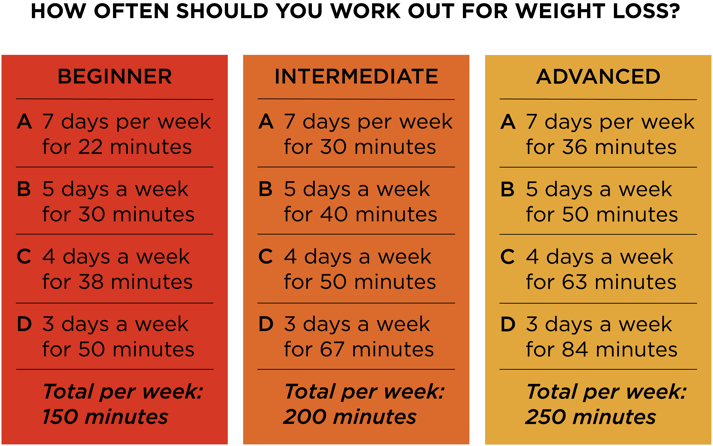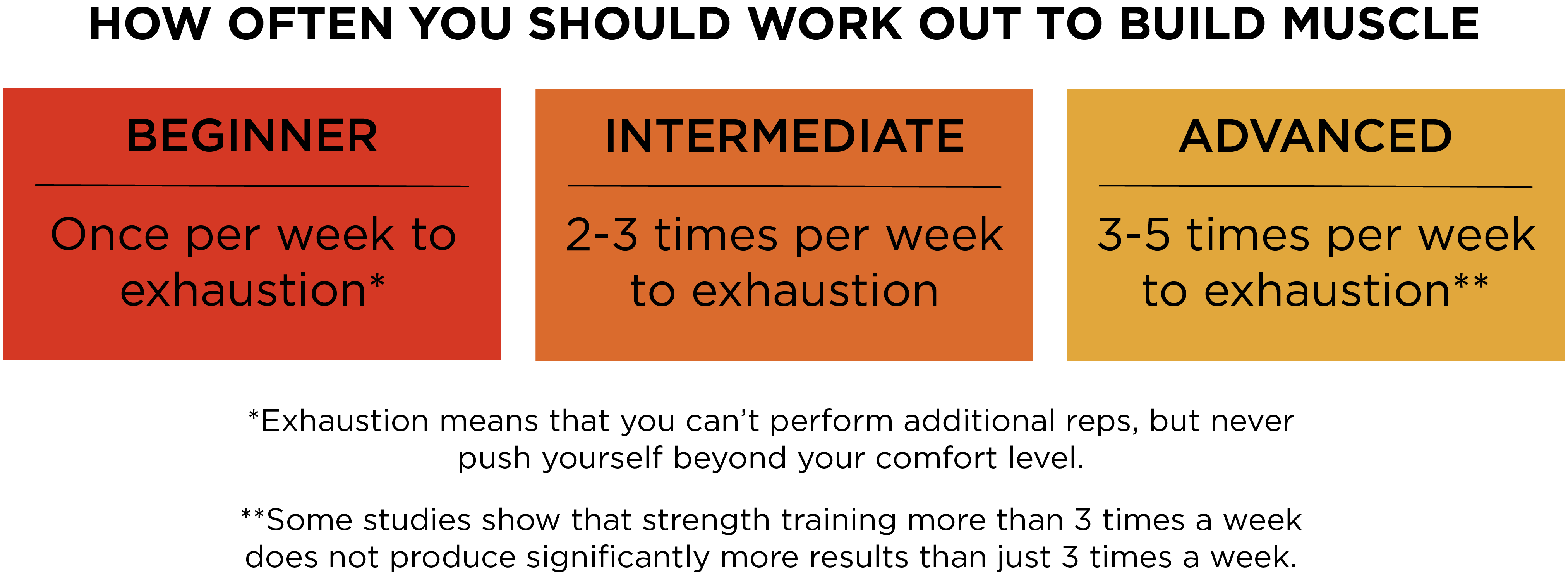MAKE A SPLASH
THIS SUMMER

Join Now For $0 Enrollment!
Learn MorePosted By: Chicago Athletic Clubs /
Going to the gym and working out can be a cathartic and enriching activity, plus it's beneficial for your health.
If you're thinking about getting a gym membership and starting to work out regularly, you might have some common questions in your head, like how often should you go to the gym, what are the best workouts for you, do you need personal training and more.
We’ll discuss a few things you can consider to determine how much you should go to the gym, what types of workouts you might do, and more. Generally speaking, you should be going to the gym twice to five times per week, but it depends on your goals. Let's dive into the specifics.
Table Of Contents:
We get it! You have a busy schedule and need to know how much time to carve out each week for exercising. The truth is, the number of times you should go to the gym depends! There's no one-size-fits all approach.
How often you should go to the gym, in no small part, depends on what you are looking to get out of your time working out.
You might be thinking, "well, that’s obvious! I want to get in better shape!" But chances are, there is more to it than that. Some other things to consider are your underlying goals and working out history.
One aspect to consider is your fitness journey, specifically your relationship with exercise and working out.
If you’re trying to bulk up and get noticeable muscle gains, you might be more interested in weight-training sessions that include curls, benches, squats, and other related compound exercises. We will discuss a few scenarios and the workout frequency you need to work out for each.
Say you want to go to the gym to get in shape — what kind of shape? Are you looking to lose weight, gain muscle, or feel healthier? Why do you want to get into shape? Are you hoping that it will boost your self-esteem? Are you worried about your overall health? Maybe you want to be strong enough to complete a specific task, like a triathlon. Determining your fitness goals is important.
Whatever your underlying needs or goals are, keep them in mind as you begin to work out. If you want to feel healthier or lose weight, you might focus on cardiovascular exercises like treadmill training, stair climber, elliptical, swimming, etc.
If you’re trying to bulk up and get noticeable muscle gains, you might be more interested in weight-training sessions that include curls, benches, squats, etc. We will discuss a few scenarios and the workout frequency you need to work out for each.
If your goal is weight loss, how often should you work out? We'll talk about a benchmark amount you can work out each week, but it is critical to remember that everyone is different, and so is their journey with working out.
Before starting an aerobic exercise regimen, consider what kind of shape you’re in, and set attainable goals. Don't overwork yourself right at the beginning and remember to ease into your routine to make it easy for yourself to stick to it.
So, how often should you work out for weight loss? Several studies have demonstrated the benefits of physical activity and its effect on weight loss. Experts have narrowed their estimation of how much exercise per week can lead to weight loss.
According to the American College of Sports Medicine, evidence indicates that moderate-intensity physical activity for between 150 and 200 minutes a week (2.5 hrs. to 3.5 hrs.) can help prevent weight gain, between 150 and 250 minutes per week (2.5 hrs. to just over 4 hrs.) can result in modest weight loss, and that more than 250 minutes a week (4 hrs.+) can result in clinically significant weight loss.
There are other factors involved as well. For example, The American College of Sports Medicine also highlights that moderate-intensity cardio exercises or other physical activity of between 150 and 200 minutes per week, combined with moderate diet restriction, can improve weight loss outcomes (though not severe diet restriction.)
Here's the takeaway. If you want to lose weight, 150 minutes (about 2 and a half hours) per week is an excellent place to start, and try to get in at least one full-body workout a week.
If you work out seven days a week, that translates to about 20 minutes a day, and if you work out five days, about 30 minutes per day. Suppose your workout plan is exercising 4 days a week, aim for a 40-minute workout.
Once you're comfortable with that length, increase your workout schedule until you reach 250 minutes per week.
If 150 minutes a week sounds too steep, start off with 100 or even 50 minutes with the goal of building up to 150+ minutes per week.

So, you know how much to work out for weight loss, but what types of workouts are you going to do? What machines might be profitable? We discussed “moderate intensity physical activity,” so what exactly is considered moderate activity?
The CDC has outlined some recommendations for adults to determine how much exercise they should get to stay healthy.
They also define moderate-intensity aerobic physical activity as “working hard enough to raise your heart rate and break a sweat.” This might include these as well as other exercises:
The goal is to get your heart rate up and work hard enough to sweat. Any healthy activity that can give you these results can help you lose weight. And don't forget to bring your gym essentials when you do hit the gym. Check out the gym schedule to see if there are any classes you can take too.
If your interest in working out is more about bulking up than slimming down, you might wonder if a moderate aerobic activity is your best path forward. While getting cardio benefits everyone — including bodybuilders — building muscles usually takes a different approach than losing weight.
We’ll explore how often you should work out, the best gym equipment for muscle building, and more.
Before we jump into which types of equipment are best, and how much to work out, let’s discuss a fancy word for muscle growth — muscular hypertrophy. Muscular means muscle-related, hyper means larger, and trophia is a Greek word that means nourishment. But it’s crucial to understand that there are two types of muscular hypertrophy:
Both are critical and serve vital functions. While sarcoplasmic muscular hypertrophy is not thought to significantly increase your strength (if at all), it does help you maintain your strength longer. You can think of it as increasing your energy stores for when you work out. Myofibrillar muscular hypertrophy can help you increase your strength.
When you’re strength training, you will experience both at different rates. If you want to increase the number of myofibrils in your muscles and gain strength, begin weightlifting with heavier weights and fewer reps.
If you want to increase your endurance and the amount of energy your muscles can store, you can focus less on heavy weights and more on doing more reps and fatiguing yourself. For a healthy balance, it’s a good idea to focus on a broad range of exercises designed to do both.
So, how often?
For weight loss, we looked at how many minutes per week you should work out. For building muscle mass, we’ll talk about how many times per week to work out. With resistance or strength training, the amount of time you spend on each workout can vary wildly, depending on your starting physical condition.
The goal is to push yourself out of your comfort zone and force your muscles to adapt to higher requirements in weight and repetition than they’re used to, almost to the point of muscle exhaustion.
While many experts agree that you need to work out at least weekly to build muscle mass, this study looked at the frequency of workouts and indicated that the difference between working out 6 times a week and 3 times a week was minimal.
So, for building muscle, you can start by going once or twice a week and work your way up to three, but between three and six times per week, you might not see noticeable differences in efficacy.

As we discussed, lifting weights and building muscle is a game of pushing your muscles to go beyond what they’re used to. To be clear, you never want to push them too far or bite off more than you can chew. Always be mindful when weight training not to go beyond your limits. You want to get out of your comfort zone, not hurt yourself.
So, what’s the best gym equipment to use? The truth is, almost anything that you can use to push your muscles harder. Here's a short list to consider:
If you’ve never used free weights before, you might want to consult a personal trainer and learn the proper lifting techniques for each exercise. Otherwise, you risk causing harm to yourself. You can also use resistance bands or your body weight.
Maybe you’re not interested in gaining muscle or losing weight; you want to stay healthy for the long-term and keep your body in great shape! Exercise is an excellent way to feel healthier and increase your energy levels. But how often do you need to work out and for how long? What types of workouts might you do?
Again, the CDC has outlined some excellent recommendations for the level of exercise adults can strive for to stay healthy. Here’s what they recommend:
While this activity level might not cause you to gain significant muscle mass or lose a significant amount of weight, it’s a great place to start if you want to feel healthy and be more active.
Best Gym Equipment/Classes to Stay in Shape
To stay in shape, aim for 150 minutes of cardio and resistance training exercises, but with less emphasis on both. Aim for two 40-minute cardio sessions, maybe on the treadmill or a spin class, plus two 40-minute sessions on a weight training circuit targeting all of the major muscle groups. If you struggle with motivation, consider joining a group fitness class or doing some interval training once a week.
Here's a sample workout regimen to start with to stay in shape:

Here are some frequently asked questions we get regarding working out.
As we discussed, that depends on if you want to burn calories and lose weight, gain muscle, or stay in shape. If you want to stay in shape, you can work out 30 minutes a day, five days a week, for 150 minutes a week.
If you’re looking to lose weight, you might shift those numbers up a bit and work out 5+ days or work out longer each session. If you’re looking to gain muscle, your workout time will likely depend on your strength level, but you’ll want to work out 2-3 times a week.
You do not need to take supplements when you work out. You can, if you’re concerned that your dietary intake is inadequate to handle an increase in physical activity, but you do not need supplements to exercise. It's always a good idea to speak with your doctor before starting any supplements if you decide to incorporate them into your diet.
Absolutely! It isn’t necessary to have a daily workout routine, as we’ve explored, but having daily gym sessions can become a valuable part of your daily routine, regardless.
As long as you’re going to the gym two to three times a week, you will see (and feel) the effects. Try switching it up and go to a class, see a personal trainer, go swimming, try some yoga, and other activities to keep it exciting.
That depends on why you’re working out. If you’re bulking up and building strength, eating extra protein might help, but the truth is the vast majority of Americans get plenty of protein. Still, if you’re looking to bulk up and you want to try out a new protein powder before you work out, the International Society of Sports Nutrition recommends between 1.4 and 2 grams of protein per kilogram of body weight per day (about .5 to 1 gram of protein per pound of body weight).
Again, this depends on your goals! If you’re weight training to bulk up, absolutely. You need rest days. You want to give your muscles plenty of time to heal between workouts (ideally 48 hours), and soreness will become an issue. If you’re trying to lose weight and only working out for 30 minutes daily, you don’t need a rest day. If you get sore and need a day off, take it!
Yes. Here's the truth, your body needs recovery time. Professional trainers or fitness enthusiasts who train five to seven days a week must maintain a crazy nutrition plan when working out that much, and the jury is still out on whether it makes a difference or not.
You can even get overtraining syndrome (OTS) and suffer from joint pain, increased fatigue, poor sleep quality (which increases fatigue), and an inability to train at your maximum level.
Yes, you can take a week off or two weeks off and enjoy your vacation - or just a much-needed break. Anything over 10-14 days and you will lose traction, so the two-week break is really the most you should go if you're focused on training.
Two-a-day workouts can be beneficial in short spurts because you get twice the activity in. But, this is not something everyone needs or should pursue. Going to the gym twice per day can lead to burnout, muscle fatigue, and OTS pretty quickly, and most people generally don't need that much activity.
Exercising twice a day is generally reserved for serious athletes under supervision. Working out twice a day here and there isn't going to hurt, but it's not necessary. Steady commitment wins the fitness race.
© 2026 Chicago Athletic Clubs. All Rights Reserved. Privacy PolicyEmployee Login
https://www.chicagoathleticclubs.com/
https://www.chicagoathleticclubs.com/services/personal-training/
0
5000
true